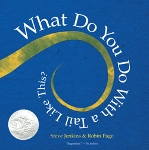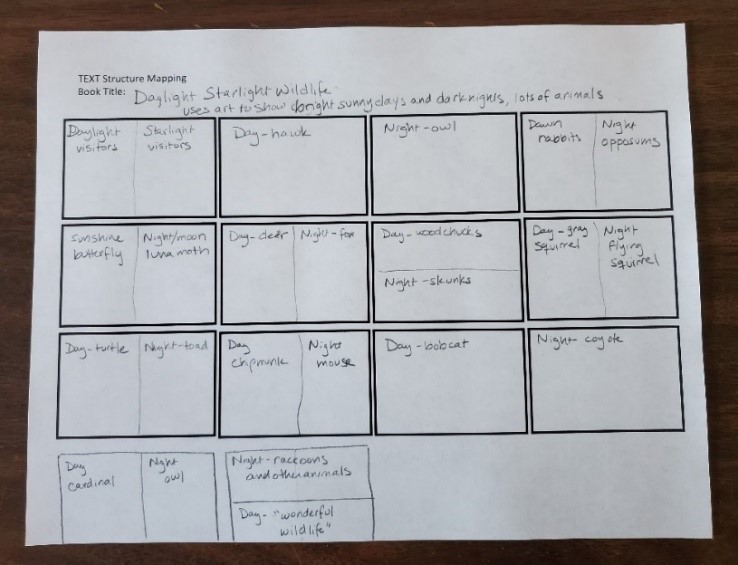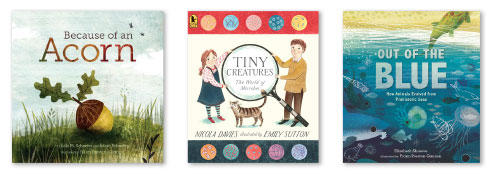Tips for Teaching Text Structures with Expository Literature | Nonfiction Strategies
With its range of text structures, innovative formatting, and rich language, expository literature is a great choice for modeling high-quality informational writing.

|
Related articles: |
Expository literature—one of the five kinds of nonfiction children’s books being published today—presents narrowly focused topics using a range of text structures as well as innovative formatting and rich, literary language, making it the perfect choice for modeling high-quality informational writing. But that’s not the only reason to choose these titles as mentor texts. Research shows that many elementary students enjoy expository nonfiction as much as or more than narratives. Expository literature features elements that make these books particularly appealing to young readers.
Why are students such big fans of expository literature? Here are some of the reasons:
“It’s all about an idea with lots of surprising or interesting examples.” —Madeline, fifth grader
“It teaches you things that you didn’t know you wanted to learn about.” —Braelyn, fourth grader
“It has facts plus it can make you think about something in a new way.” —Rowan, fourth grader
“It can surprise you. And sometimes it’s like playing a game.” —Ryan, fourth grader

Gamification in Expository Literature
Ryan’s astute observation alludes to an engaging writing technique called gamification, which children’s book author-illustrator Roxie Munro describes like this: “The author wraps the content around a concept or a construct, using clever devices to engage children, keep them interested, and impart information in creative ways.” She offers some examples like guessing games, ABCs, or counting, matching games, hidden objects, lift-the-flaps, mazes, search-n-find, puzzles, and more. “These ‘games’ have to be logically associated and integrated with the subject, not just used gratuitously,” she says. “They must immerse the young reader, not distract.”
A perfect example is 13 Ways to Eat a Fly, which utilizes a playful text structure coupled with rhyme to gamify the text. The book’s fun approach came to author Sue Heavenrich in a surprising way. “One day, I was smacking cluster flies with a swatter,” she says. “ ‘One down, a dozen to go,’ I muttered. It’s possible a light bulb went off over my head, because that’s when I realized a reverse counting structure might be an entertaining way to share information about flies. Especially if they get eaten in gruesome and disgusting ways.”
Another example is Munro’s book Hatch!, which has a question-and-answer (Q&A) text structure. The art shows an egg or a clutch of eggs, and readers try to guess what kind of bird laid it. When readers turn the page, the answer is revealed. Steve Jenkins and Robin Page employ a similar technique in their Caldecott Honor title What Do You Do with a Tail Like This? and several other books.
Author Sara Levine frequently uses a Q&A text structure because it “encourages readers to think something over,” she says. “The page-turn is a built-in pause, an opportunity for reflection, followed by surprise and delight.” In her book Eye by Eye: Comparing How Animals See, an opening question asks “What kind of animal would you be if you had eight eyes?” (The answer is a spider.) “Thinking about the topic in terms of their own bodies helps readers understand evolutionary relatedness, how we are alike and different from other animals,” says Levine.
Introducing Text Structures to Students
Because a Q&A text structure has strong kid appeal and is easy for young readers to identify, it’s a great way to introduce this important craft element to students. The following activities will help elementary-aged children begin to understand the critical role text structure plays in guiding readers through content in a clear and logical way.
Activity 1: Getting Started with Q&A
 A few weeks before your class begins its informational writing unit, invite students to create an Idea Incubator—a bulleted list of potential topics—on the last page of their writer’s notebook. Every time students have an idea or question about something they see, read, or experience, they can add it to their list. They can also include cool facts they encounter. Not only will this Idea Incubator provide students with a stockpile of writing ideas throughout the unit, the questions they’ve compiled are the perfect starting point for exploring Q&A text structure.
A few weeks before your class begins its informational writing unit, invite students to create an Idea Incubator—a bulleted list of potential topics—on the last page of their writer’s notebook. Every time students have an idea or question about something they see, read, or experience, they can add it to their list. They can also include cool facts they encounter. Not only will this Idea Incubator provide students with a stockpile of writing ideas throughout the unit, the questions they’ve compiled are the perfect starting point for exploring Q&A text structure.
 Begin the activity by reading all or part of a high-interest book with a simple Q&A text structure, such as What Do You Do with a Tail Like This? Next, divide the class into small groups and encourage the teams to discuss the following questions:
Begin the activity by reading all or part of a high-interest book with a simple Q&A text structure, such as What Do You Do with a Tail Like This? Next, divide the class into small groups and encourage the teams to discuss the following questions:
- How do the authors use questions and answers to organize the information they want to share with readers?
- Why do you think the authors structured their text in this way? Do you see any advantages?
When the groups seem ready, invite a few student volunteers to share their team’s thoughts. Classmates should feel free to agree or respectfully disagree with the presenter. They may also ask questions or offer their own insights.
Next, invite the teams to search their Idea Incubators for three to four questions that have something in common, such as a topic or idea. Each group should write the questions on a piece of lined paper, cut them out, arrange them in an order that makes sense to group, and glue them on a piece of plain white paper. While the glue dries, students can brainstorm possible titles for a Q&A book that includes the questions.
Finally, encourage the teams turn the white paper over, write their favorite title on the blank side, and create a cover for their book. If time permits, students can share their covers with the rest of the class.
Activity 2: Comparing Text Structures
Now that students have a basic understanding of how text structure can help writers organize the ideas and information they want to share, let your class know that there are a handful of common text structures that writers often choose from. One of them is Q&A. Other popular text structures include compare & contrast and problem-solution.
 As you explain the characteristics of these two text structures, list these features as well as important signal words on separate pieces of chart paper. Next, read a few pages of Daylight Starlight Wildlife by Wendell Minor and a few pages of What Do You Do When Something Wants to Eat You? by Steve Jenkins.
As you explain the characteristics of these two text structures, list these features as well as important signal words on separate pieces of chart paper. Next, read a few pages of Daylight Starlight Wildlife by Wendell Minor and a few pages of What Do You Do When Something Wants to Eat You? by Steve Jenkins.
 After letting your class know that one of these books has a compare & contrast text structure and the other has a problem-solution text structure, invite students to turn and talk with a neighbor about which book has each structure. Encourage students to review the characteristics you listed on chart paper as they make their decision. When the buddy conversations wind down, ask a few student volunteers to share their thinking. You may wish to add some of their ideas to the chart paper lists.
After letting your class know that one of these books has a compare & contrast text structure and the other has a problem-solution text structure, invite students to turn and talk with a neighbor about which book has each structure. Encourage students to review the characteristics you listed on chart paper as they make their decision. When the buddy conversations wind down, ask a few student volunteers to share their thinking. You may wish to add some of their ideas to the chart paper lists.
When you’re confident that students understand why Daylight Starlight Wildlife has a compare & contrast text structure and What Do You Do When Something Wants to Eat You? has a problem-solution text structure, divide the class into small groups. Pass out copies of Daylight Starlight Wildlife to half of the groups and What Do You Do When Something Wants to Eat You? to the other half.

Encourage each group to create a text structure map, as shown above. This tool visually represents a book’s text structure by summarizing the information on each double-page spread and highlighting the signal words. Let students know that this sort of graphic organizer is a great way to identify and understand the overall text structure of a nonfiction book.

You may wish to repeat this activity using books with the other three major text structures included in state English language arts curriculum standards. The following books work well because they have clear, easy-to-identify text structures:
- Cause & Effect: Because of an Acorn by Lola M. Schaefer and Frann Preston-Gannon
- Description: Tiny Creatures: The World of Microbes by Nicola Davies and Emily Sutton
- Sequence: Out of the Blue: How Animals Evolved from Prehistoric Sea by Elizabeth Shreeve and Frann Preston-Gannon
Read the the final article in this three-part series focusing on how expository literature titles with a list text structure can be used as mentor texts for writing five-paragraph essays.
Melissa Stewart has written more than 200 science books for children, including the Sibert Medal Honoree Summertime Sleepers: Animals that Estivate, illustrated by Sarah S. Brannen. She co-wrote 5 Kinds of Nonfiction: Enriching Reading and Writing Instruction with Children’s Books and edited the anthology Nonfiction Writers Dig Deep: 50 Award-winning Authors Share the Secret of Engaging Writing.
Terrell A. Young is professor of children’s literature at Brigham Young University in Provo, Utah. He has served as president of the United States Board on Books for Young People (USBBY), ILA Children's Literature and Reading Special Interest Group (CL/R), and the NCTE Children's Literature Assembly (CLA).
RELATED
The job outlook in 2030: Librarians will be in demand
The job outlook in 2030: Librarians will be in demand
ALREADY A SUBSCRIBER? LOG IN
We are currently offering this content for free. Sign up now to activate your personal profile, where you can save articles for future viewing





Add Comment :-
Be the first reader to comment.
Comment Policy:
Comment should not be empty !!!